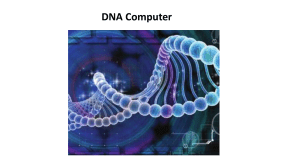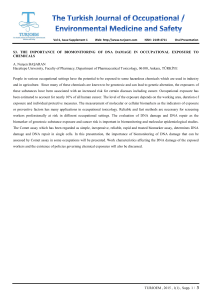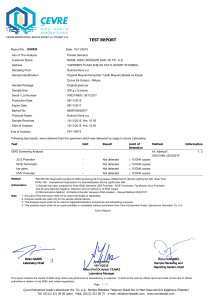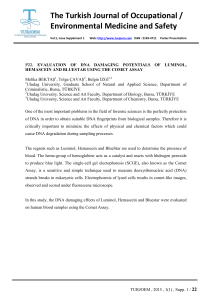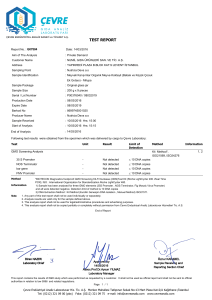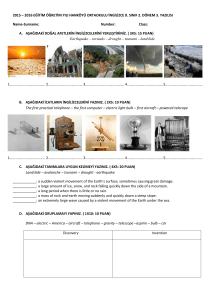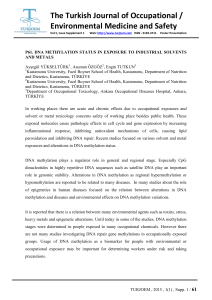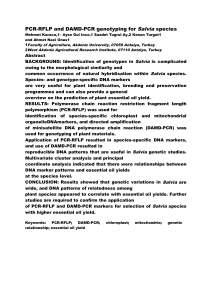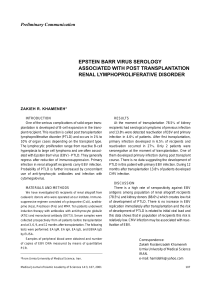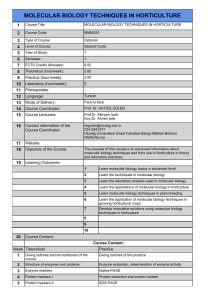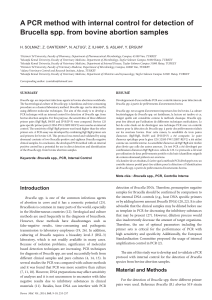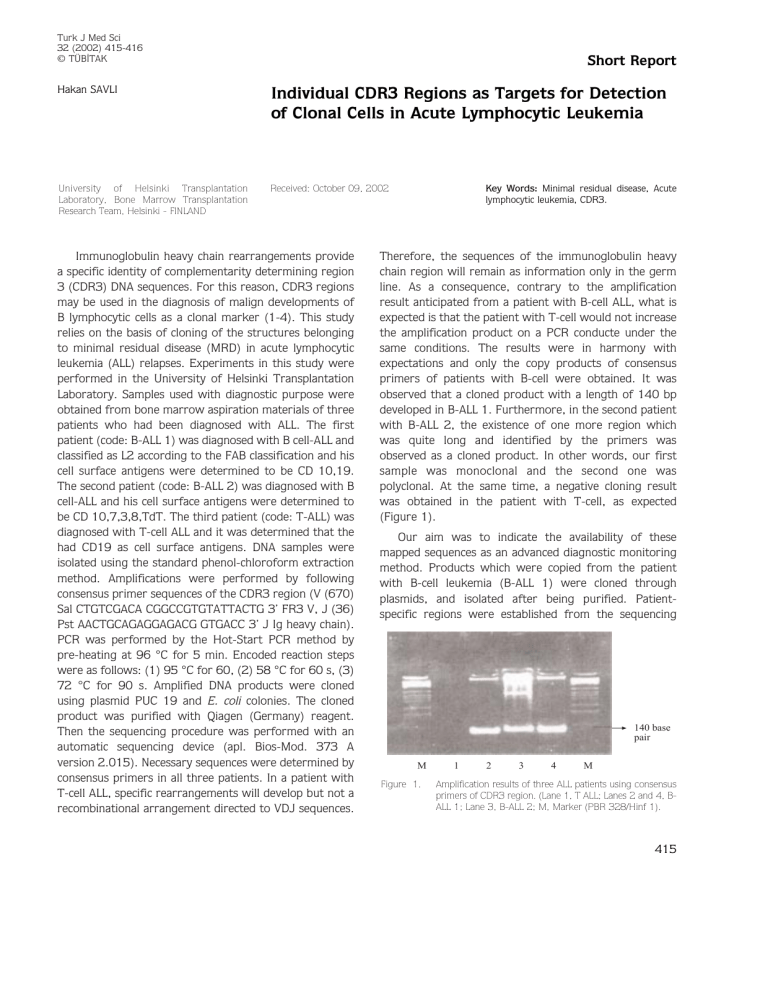
Turk J Med Sci
32 (2002) 415-416
© TÜB‹TAK
Short Report
Hakan SAVLI
Individual CDR3 Regions as Targets for Detection
of Clonal Cells in Acute Lymphocytic Leukemia
University of Helsinki Transplantation
Laboratory, Bone Marrow Transplantation
Research Team, Helsinki - FINLAND
Received: October 09, 2002
Immunoglobulin heavy chain rearrangements provide
a specific identity of complementarity determining region
3 (CDR3) DNA sequences. For this reason, CDR3 regions
may be used in the diagnosis of malign developments of
B lymphocytic cells as a clonal marker (1-4). This study
relies on the basis of cloning of the structures belonging
to minimal residual disease (MRD) in acute lymphocytic
leukemia (ALL) relapses. Experiments in this study were
performed in the University of Helsinki Transplantation
Laboratory. Samples used with diagnostic purpose were
obtained from bone marrow aspiration materials of three
patients who had been diagnosed with ALL. The first
patient (code: B-ALL 1) was diagnosed with B cell-ALL and
classified as L2 according to the FAB classification and his
cell surface antigens were determined to be CD 10,19.
The second patient (code: B-ALL 2) was diagnosed with B
cell-ALL and his cell surface antigens were determined to
be CD 10,7,3,8,TdT. The third patient (code: T-ALL) was
diagnosed with T-cell ALL and it was determined that the
had CD19 as cell surface antigens. DNA samples were
isolated using the standard phenol-chloroform extraction
method. Amplifications were performed by following
consensus primer sequences of the CDR3 region (V (670)
Sal CTGTCGACA CGGCCGTGTATTACTG 3’ FR3 V, J (36)
Pst AACTGCAGAGGAGACG GTGACC 3’ J Ig heavy chain).
PCR was performed by the Hot-Start PCR method by
pre-heating at 96 °C for 5 min. Encoded reaction steps
were as follows: (1) 95 °C for 60, (2) 58 °C for 60 s, (3)
72 °C for 90 s. Amplified DNA products were cloned
using plasmid PUC 19 and E. coli colonies. The cloned
product was purified with Qiagen (Germany) reagent.
Then the sequencing procedure was performed with an
automatic sequencing device (apl. Bios-Mod. 373 A
version 2.015). Necessary sequences were determined by
consensus primers in all three patients. In a patient with
T-cell ALL, specific rearrangements will develop but not a
recombinational arrangement directed to VDJ sequences.
Key Words: Minimal residual disease, Acute
lymphocytic leukemia, CDR3.
Therefore, the sequences of the immunoglobulin heavy
chain region will remain as information only in the germ
line. As a consequence, contrary to the amplification
result anticipated from a patient with B-cell ALL, what is
expected is that the patient with T-cell would not increase
the amplification product on a PCR conducte under the
same conditions. The results were in harmony with
expectations and only the copy products of consensus
primers of patients with B-cell were obtained. It was
observed that a cloned product with a length of 140 bp
developed in B-ALL 1. Furthermore, in the second patient
with B-ALL 2, the existence of one more region which
was quite long and identified by the primers was
observed as a cloned product. In other words, our first
sample was monoclonal and the second one was
polyclonal. At the same time, a negative cloning result
was obtained in the patient with T-cell, as expected
(Figure 1).
Our aim was to indicate the availability of these
mapped sequences as an advanced diagnostic monitoring
method. Products which were copied from the patient
with B-cell leukemia (B-ALL 1) were cloned through
plasmids, and isolated after being purified. Patientspecific regions were established from the sequencing
140 base
pair
M
Figure 1.
1
2
3
4
M
Amplification results of three ALL patients using consensus
primers of CDR3 region. (Lane 1, T ALL; Lanes 2 and 4, BALL 1; Lane 3, B-ALL 2; M, Marker (PBR 328/Hinf 1).
415
Individual CDR3 Regions as Targets for Detection of Clonal Cells in Acute Lymphocytic Leukemia
sample. These regions were synthesized as
oligonucleotide nested primers. Only the sequences which
indicated patient-specific clonal variance might be used as
an amplification sign in relapses and post-transplantation
samples. The synthesized nested primers which had high
sensitivity to detect MRD structures in further controls
were entered in PCR together with bone marrow or
blood DNA samples from different periods, which were
obtained from pre- and post- bone marrow
transplantation cells. An amplification product of
expected length was found in all samples (Figure 2).
Findings obtained through nested primers in our
experiments are in harmony with the results of
hybridization studies of Billadeu et al. through allele
specific oligonucleotides from ALL, CLL and MM patients
and the results obtained by Yamada et al. through
oligonucleotide probes on ALL patients (5-6). Some
researchers have pointed out the benefits of adding
another sign to the immunoglobulin heavy chain in PCR
based ALL-MRD detection studies. Hence, it is possible to
observe a decrease in false negative results obtained on
MRD structures. Despite being expensive and requiring a
great deal of labour, these studies indicate the value of
using more than one sign. Consequently, it is clear that
important gains will be acquired regarding the sensitivity
despite an increase in cost, when studies similar to ours
are conducted by using more than one oligonucleotide
consensus primer (7). Clinical requests underline the
importance of the development of purification methods
for autologous transplantations while detecting leukemic
clones. The disadvantage of both combined cloning and
140 base
pair
M
Figure 2.
1
2
3
4
5
6
Amplification results of B-ALL 1 patient using patientspecific primers of CDR3 region. (M, Marker (PBR 328 /
Hinf 1); Lane 1, control - foreign DNA template; Lane 2,
peripheric blood DNA sample in primer diagnosis; Lane 3,
bone marrow DNA sample in primer diagnosis; Lane 4,
peripheric blood DNA sample in remission after second
chemotherapy; Lane 5, harvested stem cells DNA sample
before bone marrow transplantation; Lane 6, bone marrow
DNA sample in relapse after bone marrow transplantation).
PCR studies based on the CDR3 region is the long time
period and cost required for application. Amplification,
cloning, purification and sequencing studies with
consensus primers necessitate a special laboratory
regarding personnel and order.
Correspondence author:
Hakan SAVLI
ODTU Sitesi, 327. Sok., No: 27
Karakusunlar, Balgat - TURKEY
[email protected]
References
1.
Alberts B, Bray D, Lewis J, et al.: Molecular Biology of the Cell. Garland Publishing Inc. NY., 1989.
2.
Kabat E, Wu TT, Bilofsky H: Sequences
of immunoglobulin chains. NIH Publication 80: 2008, 1988.
3.
Watson J, Hopkins N, Roberts J, et al.:
Molecular biology of the gene. Benjamin
Cummings Publishing Company Inc.
1987.
416
4.
Raymond L, Vivian C, Chan TK, et al.:
Detection of immunoglobin gene
rearrangement in B-Cell lymphomas by
polymerase chain reaction gene amplification. Hematological Oncology; 10:
149-154, 1992.
5.
Billadeu D, Blackstadt M, Greipp P, et
al.: Analysis of B lymphoid malignancies
using allele-specific polymerase chain
reaction: A technique for sequential
quantitation of residual disease. Blood
78: 3021-3029, 1991.
6.
Yamada M, Hudson S, Tournay O, et al.
Detection of minimal disease in
hematopoietic malignancies of the BCell lineage by using third-complementarity-determining region (CDRIII) – specific probes. Proc. Natl. Acad. Sci. USA86: 5123-5127, 1989.
7.
Miyamura K, Takeo T, Kataoka T, et al.:
Detection of MRD in Philadelphia chromosome positive ALL: rationale for Bone
Marrow Transplantation from the PCR
reaction point of view. Leukemia Lymphoma 11 (3-4): 1993.

